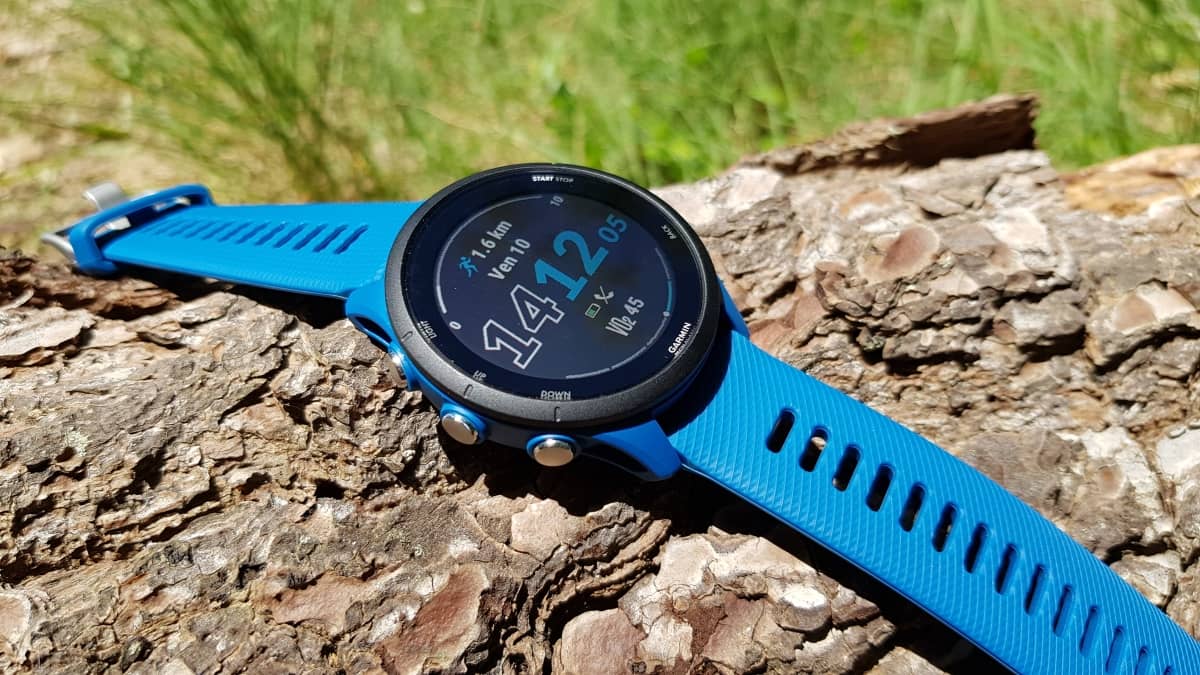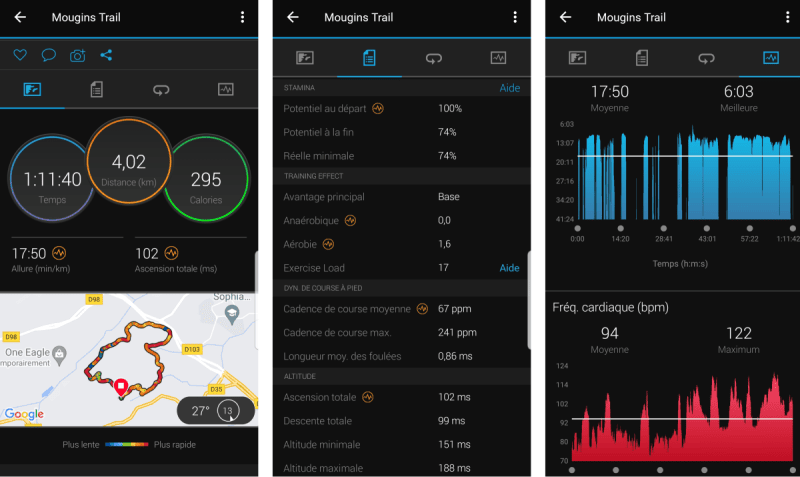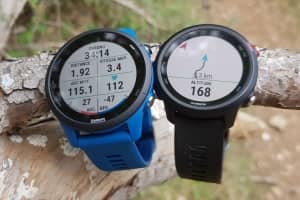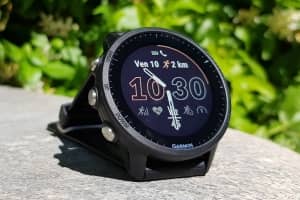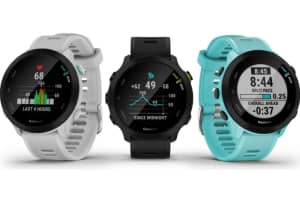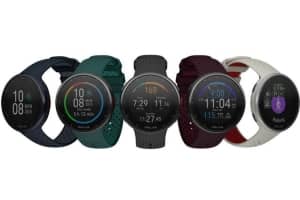- About this test
- Garmin Forerunner 255 presentation: the right compromise for runners, trailers and triathletes
- Technical data
- Forerunner 255 test: design and technical specifications
- GPS test: ultra-precise multi-band GPS
- Altimeter test: reliable and accurate
- Sports functions
- Testing GPS navigation and outdoor functions
- Autonomy test
- Activity tracking and connected features
- The application
- Our opinion
- Verdict
- Price and availability
Forerunner 255 test summary
Weight : 39g (255S) and 49g (255)
Dimensions: 41 x 12.4 and 45.6 x 12.9mm
Display: Non-touch MIP, 28 and 33 mm, 218 x 218px and 260 x 260 px
Use: running, triathlon, trail, 30+ sports
Autonomy : 26-30h / 12-14d (GPS / watch)
Less: Less affordable than the previous model, buttons a bit hard
Verdict: The Forerunner 255, clearly more complete than the previous model, is in our eyes the watch offering the best compromise for most sportsmen. The barometric altimeter makes it suitable for trail running, skiing and hiking. The 2 case sizes offer a perfect fit for all wrists. The sports tools are more complete than those of the previous model. The watch offers a triathlon profile. The dual-frequency GPS is ultra-precise. The higher price is justified by these additions but makes the Forerunner 255 less accessible to everyone. A watch that should still be a hit in the next few years and that is close to the top of the range model but without mapping and without a touch screen. We loved the old model, we loved this one!
Buy Forerunner 255
Buy Forerunner 255 Music
Commercial links. Prices are not contractual. Please visit the merchant site.
About this test
For all the tests or detailed reviews we carry out, we do not receive any remuneration from the manufacturer. We do not publish sponsored content on our site. All our tests are brand independent. Our goal is to provide free, neutral, reliable and useful information to help users choose, buy and use sports equipment (watches and fitness equipment).
Garmin Forerunner 255 presentation: the right compromise for runners, trailers and triathletes
The Forerunner 255 and Forerunner 255 Music from Garmin are 2 mid-range cardio-GPS watches offering full sports functions and GPS navigation (route tracking, etc.). They replace the Forerunner 245 and Forerunner 245 Music, 2 models released in 2019, which were starting to get a bit old. Note that in 2023, Garmin launched the Forerunner 265, equivalent to the Forerunner 255 but with an AMOLED screen. Read our test of the Forerunner 265.
For a detailed comparison between the old and new models, see our Forerunner 245 versus 255 comparison.
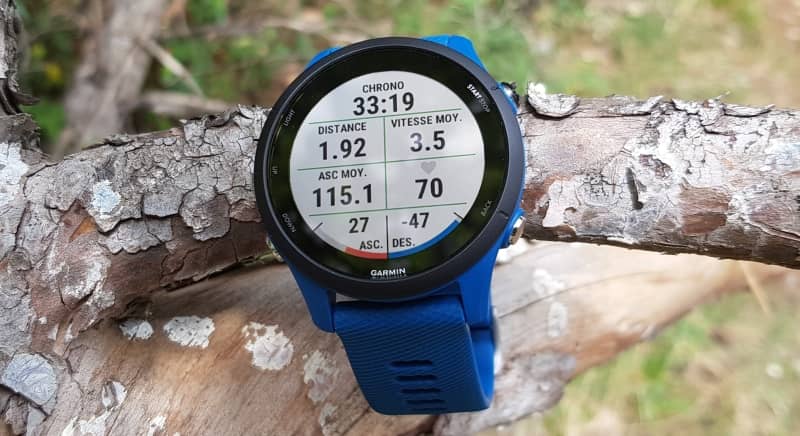
A watch that becomes multisport and triathlon
This new model, originally designed for running, is now multi-sport and offers a triathlon profile. In concrete terms, you can chain several sports activities together without having to stop recording one activity to start the next. Just press a button to move on to the next sport.
This makes the Forerunner 255 the cheapest triathlon watch from Garmin. Finally, good news for triathletes who have been looking for an affordable Garmin watch.
It can be used for many other sports, about thirty in total including running, swimming (open water and pool), cycling, hiking, trail running, etc... (see list below in the article)
2 case sizes and a new screen
The watch is now available in 2 case sizes:
- Forerunner 255S and 255S Music: the smaller 41mm diameter model (instead of 42mm for the Forerunner 245), perfect for thin wrists. The screen is smaller (1.1" instead of 1.2" or 27.5mm) and smaller in definition to fit the new size (218 x 218px instead of 240 x 240px)
- Forerunner 255 and 255 Music: the 45.6 mm diameter model with a larger screen (1.3" or 33 mm) and better definition (260 x 260 px). It offers greater reading comfort.
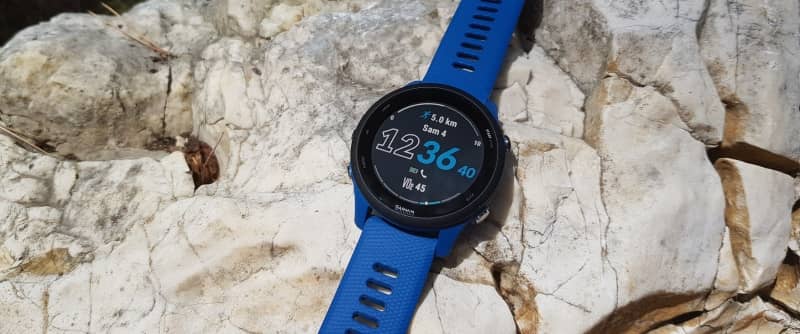
New sensors including barometric altimeter and multiband GPS
The Forerunner 255 brings many new features. In particular, it is equipped with a barometric altimeter and thus becomes usable for the mountains and outdoor (trail, hiking, skiing). We feel that Garmin is preparing its watch for native power on the wrist without an external sensor as Coros and Polar already do. You will find our test of the altimeter later in this article.
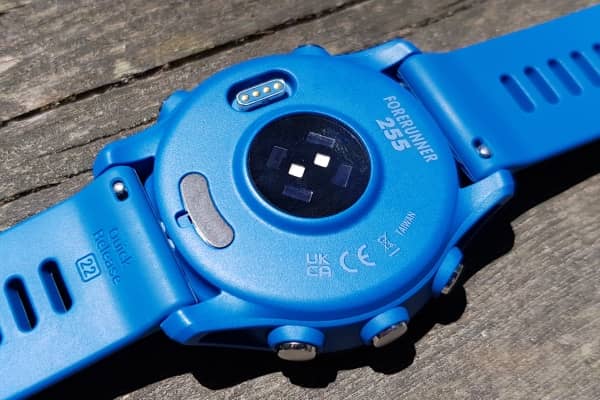
It benefits from the latest optical wrist heart rate monitor (4 th generation), which is more reliable than the older generation, and a pulse oximeter for blood oxygen level (SpO2) measurements. It is fitted to recent Garmin models.
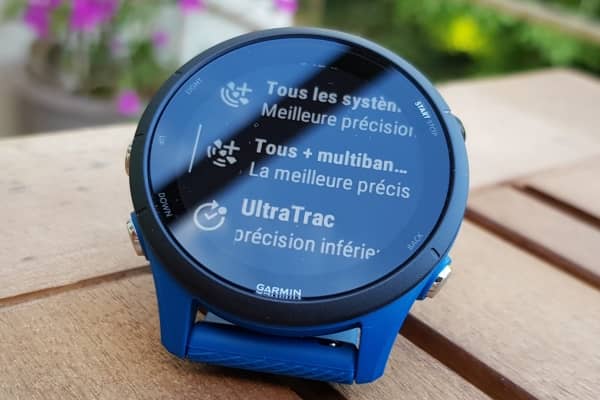
Another big novelty, Garmin equips its watch with a GPS multi GNSS and multiband (L1+L5) capable of correcting errors related to the reverberations of GPS signals, a point particularly useful in the city, in the mountains and in the forest (read our explanations of the multiband GPS and its interest on a cardio-GPS watch). We have tested it: it is excellent (read our test further down in the article and the detailed test in the video.
It is a surprise to find it on a mid-range watch knowing that the standard Fenix 7, which is worth €700, is not equipped with it. To benefit from it on the Fenix series, you have to buy the Fenix 7 Sapphire Solar, which is sold from 900 €...
The watch also has a thermometer (new), a gyroscope (new) and an accelerometer. It can be combined with external ANT+ and Bluetooth compatible sensors (speed, cadence, stride, power, heart rate monitor, etc.).
Summary of features
| Features | 255S | 255 | 245 |
|---|---|---|---|
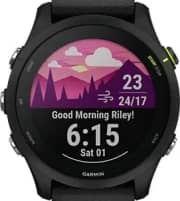 |  | 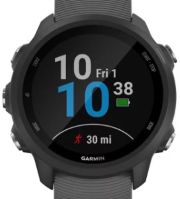 | |
| Price (€) | 350 | 400 | 250-280 |
| Case diameter (mm) | 41 | 45,6 | 42,3 |
| Thickness (mm) | 12,4 | 12,9 | 12,2 |
| Weight (g) | 39 | 49 | 38,5 |
| Touch screen | X | X | X |
| Color screen | • | • | • |
| Screen size (mm) | 27,5 | 33 | 30,4 |
| Screen size (inches) | 1,1" | 1,3" | 1,2" |
| Screen resolution (px) | 218x218 | 260x260 | 240 x 240 |
| Solar charging | X | X | X |
| Bezel | Reinforced polymer | Reinforced Polymer | Reinforced polymer |
| Glass | Corning Gorilla 3 | Corning Gorilla 3 | Corning Gorilla 3 |
| Multiband GPS | • | • | X |
| Barometric altimeter | • | • | X |
| Thermometer | • | • | X |
| Wi-Fi | X | X | • |
| Wrist cardio | • | • | • |
| Pulse oximeter | • | • | • |
| Battery life (GPS only) | 26h | 30h | 24h |
| Water resistance | 5 ATM | 5 ATM | 5 ATM |
| Strap size | 18 mm | 22 mm | 20 mm |
| Interchangeable strap without tools | • | • | • |
New features

Among other big changes, Garmin is adding native running power on the wrist and workouts that include power. To take advantage of this, you need to use an external sensor (running dynamics pods or HRM-Pro belt for example). On the other hand, Garmin does not offer measurement without an external sensor (less accurate though) like Polar and Coros do.
There are new features, some of which are already present on the Fenix 7 and Epix:
- Enhanced training status that displays progress
- Morning report: a report constructed each morning summarising the day (consolidation of sleep, recovery and training data).
- HRV Status (Heart Rate Variability): a new widget displaying general health status (overview of general wellbeing, recovery and performance level) taking into account HRV during sleep.
- Running widget: to plan your running strategy
- Garmin Pay to pay for purchases with the watch
- Daily training suggestions
- Altitude profile, elevation gain, ascent rate, slope directly on the watch
In addition to these new features, the Forerunner 255 has all the functions of the previous model. It offers more than 30 sports profiles, comprehensive training functions, including the programming of simple or complex training sessions from the Garmin Connect application, running dynamics (stride analysis), comprehensive physiological measurements (VO2max, aerobic and anaerobic Training Effect, training load, Body battery, training status and load, etc.), Garmin Coach, PacePro.
It also offers GPS navigation functions, including route tracking with turn-by-turn guidance and tracking back to the start.
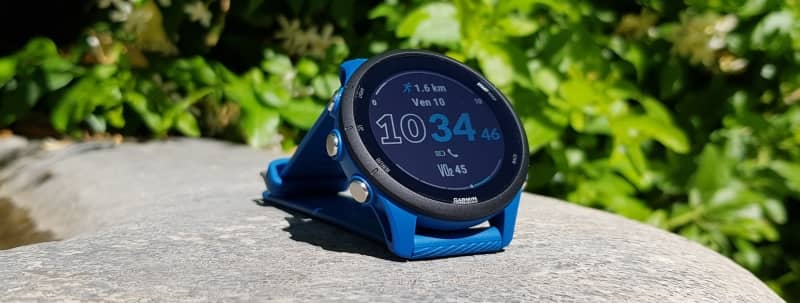
Connected functions and health tracking: Garmin Pay on the watch
Like the old model, Garmin offers 2 versions, one without an MP3 player (Forerunner 255S and 255), the other with MP3 player (Forerunner 255S Music and 255 Music) sold for €50 more. The version with an MP3 player allows you to load up to around 500 music tracks that you can listen to with Bluetooth headphones. You can also listen to streaming music with a smartphone nearby. The two models (with and without MP3 player) are identical in terms of sports features.
The Garmin 255 features contactless payment solution Garmin Pay, offers activity and health tracking and features for security.
The Music model offers Wi-Fi for data transmission (synchronization) and watch updates. Wi-Fi is not essential (Bluetooth does the job just fine) but it simplifies updates to the watch, transferring routes from the application and synchronising data (no need to connect the watch to a PC or switch on your phone to benefit from it).
There are many other smart features such as LiveTrack (for internet tracking), weather, calendar, VIRB camera control and smartphone notifications. The Forerunner 255 has access to the Connect IQ shop directly from the watch.
It offers comprehensive health and activity monitoring. It also includes assistance and safety features such as fall detection and fall assistance with real-time GPS coordinates.
A slightly better autonomy
The Forerunner 255 offers better battery life. However, beware of using the GPS in dual frequency mode. It consumes twice as much energy. This is the price to pay for better accuracy.
| Model | 255S | 255 | 245 |
|---|---|---|---|
| Watch mode | 12 d | 14 d | 7 d |
| GPS mode | 26 h | 30 h | 24 h |
| Multi-GNSS | 20 h | 25 h | - |
| Multi-GNSS and dual frequency | 13 h | 16 h | - |
| GPS mode with music | 5,5 h | 6,5 h | 6 h |
| UltraTrac mode | • | • | • |
| Rechargeable during activity | • | • | • |
| Power Manager | • | • | X |
Price
The Forerunner 255 and Forerunner 255 Music are available for sale from €349 and are offered in 8 colours (2 colours per model).
- Forerunner 255S / 255: €349
- Forerunner 255S Music / 255 Music: € 399
These prices are €50 higher than the prices of the previous models when they were released, but for a watch that is much more complete in terms of sensors and features. Garmin's best-selling watch is now a little higher, closer to the top-of-the-range model Forerunner 955 but a little less affordable.

Who is the Forerunner 255 for?
It is aimed at all sportsmen and women, from beginners to advanced. Much more complete than the Forerunner 55 (the entry-level model for runners) and a little less sophisticated than the Forerunner 955 (the top-of-the-range model with mapping), it is perfect for most sportsmen and women, even experienced ones, who practise endurance sports such as running, trail running, cycling, swimming (sea and open water) and even outdoor activities (skiing, hiking, etc.)
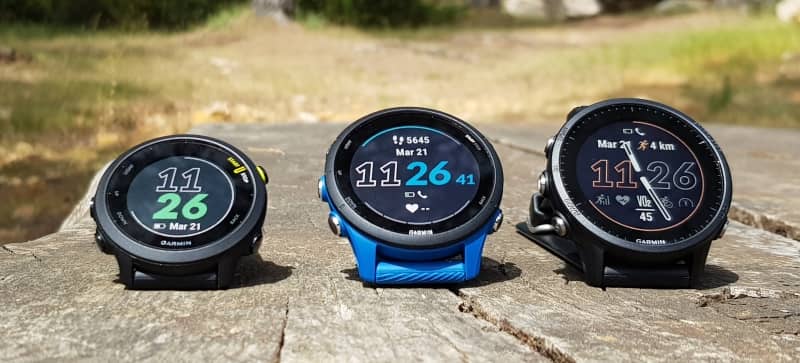

What is the purpose of a watch?
Originally designed for runners, this watch can now be used for over 30 sports. This new model is multi-sport and offers a triathlon profile. The new barometric altimeter now allows it to be used for outdoor activities such as trail running, skiing and hiking (dedicated profiles).
Technical data
53 g
Dimensions
FR255S: 41 x 41 x 12.4 mm
FR255: 45.6 x 45.6 x 12.9 mm
Display
Color MIP, 1.1" (27.5 mm) at 240 x 240 px (FR255S) and 1.3" (33 mm) at 260 x 260 px, (FR255), Corning Gorilla glass
Autonomy (GPS / multiband / watch modes)
FR255S : 26 h / 13 h / 12 d
FR255: 30 h / 16 h / 14 d
GPS
Multi-GNSS and dual frequency L1+L5
True multi-sport
Yes
Recommended activities
Running, triathlon, outdoor/outdoor, swimming, hiking, trail/ultratrail, skiing (cross-country, downhill, snowboard) (30+ profiles available)
Connectivity
iPhone, Android, Wi-Fi (Music model). Bluetooth and Wi-Fi wireless data transfer (Music model).
Heart rate monitor
Yes, optical on wrist
Topographical maps
-
Yes
On-board music player
Music model only
Telephony / 4G
-
ECG
-
Barometric altimeter
Yes, auto-calibrated or manual
Compass
Yes
Thermometer
Yes
Weather
Yes + storm alerts
Waterproof
5 ATM (50 m), swimming
Other
Running power with external sensor, full sports functions and physiological measurements, route tracking, return to start, altitude profile, battery manager
Other models
Forerunner 245 (previous model)
Forerunner 55 (entry-level)
Forerunner 955 (high-end)
Forerunner 255 test: design and technical specifications
Lightweight and nice looking case, buttons a bit stiff and noisy

The Forerunner 255 has a lightweight case (only 39g for the Forerunner 255S, 49g for the Forerunner 255) made of composite material. The glass is made of Corning Gorilla, an ultra-resistant glass used in most smartphones. The strap is made of silicone. Its width varies according to the model (18 mm for the Garmin 255S and 22 mm for the Garmin 255). Unlike the Forerunner 955, it is equipped with the QuickFit&trade quick-release system, so that it can be changed easily, without tools.
We tested the "big" model (Forerunner 255) which is 46.5 mm and blue in colour. The watch is very comfortable to wear and looks great on the wrist. We thought that the blue colour would be a bit flashy for everyday wear. On the contrary, the watch is really nice and gives a sporty look. Its blue display screen, which reminds the colour of the strap, looks really good. The small model, which is designed more for women, is only available in pink and grey, which is a shame. The Music models are available in black and white.
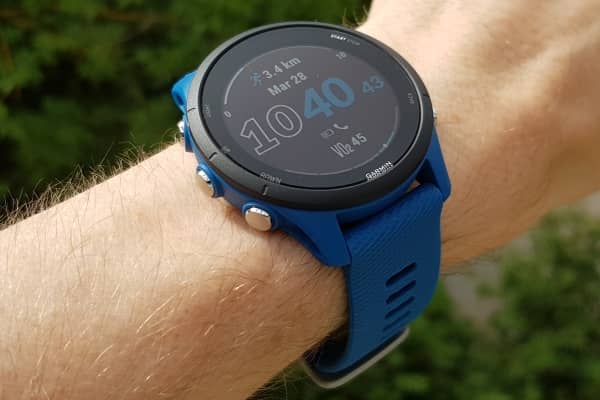
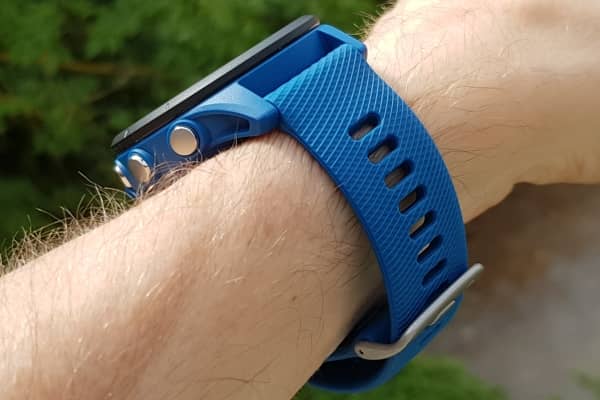
As for size, we were used to the smaller Forerunner 245, which is perfect for thin wrists, but this model is finally well suited for thin to intermediate wrists, probably also for wide wrists.
The strap is ultra soft and of good quality. It is perhaps a little stiffer than the Forerunner 245, but still very comfortable to wear. It is easy to put on and take off and does not wear out after almost a month of testing.
The buttons are a bit disappointing. They are stiffer than those of the old model (same observation for the Forerunner 955) and a little noisy (small spring noise that the Forerunner 245 did not make). It seems that Garmin has pulled on the quality. This is not the case with the Fenix 7 whose buttons are very soft and very pleasant to use.
Finally, the volume of the Forerunner 255's audible notifications is quite high compared to other Garmin watches and this is a bit surprising at first!

The screen: a thicker border and 6 data fields
The screen of the Forerunner 255 (large model) is comfortable to read, sharp, very readable in the sun thanks to the MIP technology, but also in dark places (forest, etc.) thanks to an efficient backlight which can be adjusted from 10 to 100%. It is set to 20% by default and this is already sufficient. For more comfort, we have set it to 30%.

The black border around the screen of the larger model (255) is thicker than that of the Forerunner 245 and it shows! With the increase in screen size being proportionately greater than the increase in case diameter, one would have thought that the bezel would be thinner. In reality, Garmin has made the bezel so thin that the border has become 1 mm thicker! It's a pity because it doesn't embellish the model.
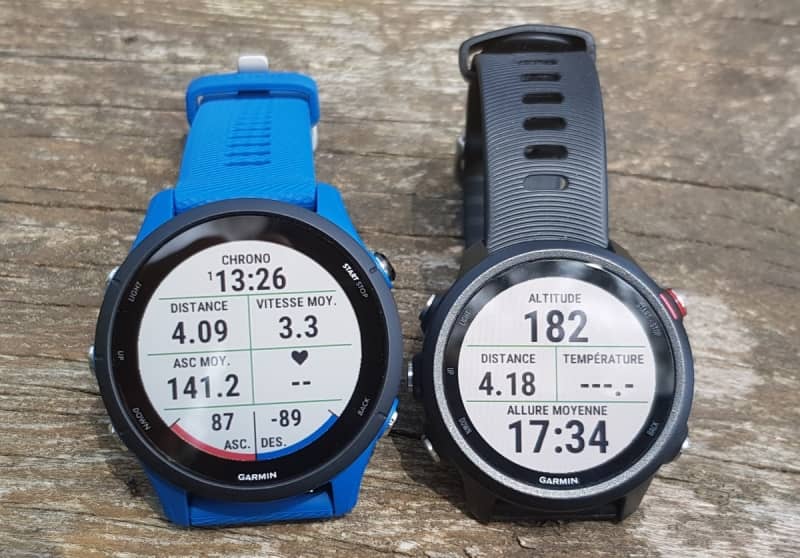
The screen of the two watches (255S and 255) has evolved with a display that can now show up to 6 data fields per sports screen. This is very practical even if the display is a little small on the 27 mm screen of the Forerunner 255S.
The fields are enriched. Power fields can be displayed. Some graphs and gauges are also available. With the ascents/decents gauge (2 data in 1), you can display 7 fields on the watch!
Memory, sealing, operating temperature
The watch has 4GB of memory. It is waterproof up to 50 metres (5 ATM), so can be used for swimming but not diving. It can be used between -20°C and +60°C, a wide and rather good range. It should be noted that a watch exposed to direct sunlight can easily reach high temperatures.
GPS test: ultra-precise multi-band GPS
The Forerunner 255 offers multi-GNSS GPS (it can connect to multiple satellite systems at the same time) but also multi-frequency or multi-band (able to receive multiple signals per satellite). The same can be found on the Fenix 7 Sapphire Solar or the Epix, the most expensive models in the range.
Multiband is a real asset because of its remarkable accuracy, which we have seen during our tests (see also our full video below). By receiving 2 signals per satellite and at different frequencies, it offers a better sensitivity and is able to correct certain errors, in particular errors caused by the reverberation of signals against buildings in the city or rocks and trees in the forest and mountains (read our explanations of multiband GPS and its interest on a cardio-GPS watch).
There are 3 modes to choose from:
- GPS only: for an optimal autonomy (26 or 30 h depending on the model) but a not always optimal accuracy (see the test in our video)
- Multi-GNSS: for excellent accuracy and slightly higher battery consumption (the right compromise)
- Multi-GNSS and Multiband: for excellent accuracy but half the battery life
| Multi-GNSS | Multiband | |
|---|---|---|
| Benefits | Faster docking Greater GPS stability Greater reliability (track, distance) in areas with poor reception (more likely to find 4 satellites) More accurate route tracking | Greater accuracy of GPS track, total distance and average pace Greater GPS sensitivity More accurate route tracking More accurate than multi-GNSS alone |
| Disadvantages | Higher battery consumption | 2 to 3 times more battery consumption |
Our tests have shown a significant difference between the 3 available GPS modes (GPS only, all GNSS and multiband + all GNSS). The track is almost perfect with multiband and much more approximate (in comparison) in GPS only mode. The accuracy of the Forerunner 255 is even better than the Fenix 7 Sapphire Solar. It's possible that this is a software enhancement that the Fenix 7 will inherit in future model updates. It is true that multiband is a recent development in GPS watches. It only appeared at Garmin in early 2022.
Downtown GPS testing
We tested the Forerunner 255 in town and in a small village with narrow streets and stone houses. The GPS is very poor in places.
The accuracy of the Forerunner 255's multi-band GPS is remarkable. The passage under the houses to reach the small street of Badier (bottom of the map) makes it almost impossible to hang on to the GPS. Here, the track is excellent for models with multiband GPS (FR 255, FR 955, Fenix 7 Sapphire Solar). The Forerunner 55, in GPS + GALILEO mode, has a little more difficulty in the village and gets lost there. The few zigzags in the upper right corner correspond to a photo break during which the watches were not moving!

Further along the road, in a clear environment, the 3 watches equipped with the multiband system make a nearly perfect trace. The track appears on the right side of the road, with a small gap for the Fenix 7 and especially for the Forerunner 55. We can see some slots made on the right (street crossings).

At this other location, the Forerunner 255 offers a very accurate track. You can see a small gap of a few meters to the left of the road on 2 occasions like the other 3 watches. The crenulations are clearly visible. The Forerunner 55 (GPS + GALILEO mode) has many more gaps.


In this other test, our goal was to compare the accuracy of the Forerunner 255's multiband GPS with that of 2 other watches equipped with multiband GPS (Coros Vertix 2 and Garmin Fenix 7 Sapphire Solar). To highlight the value of multiband GPS, we also tested 2 watches that are not equipped with it: the Forerunner 245 and the Forerunner 55, both programmed in GPS+GALILEO mode.
The Forerunner 255's multiband GPS accuracy is excellent with near perfect tracking (the same as we found in our test of the Forerunner 955), almost to the metre. The Fenix 7 Sapphire Solar and the Coros Vertix 2 do a little worse in this and other tests we have conducted with these watches. That said, they may not have benefited at the time from the software improvements that Coros and Garmin have made in the meantime. We would have to do the test again later to be sure.

Testing the GPS in the forest
The Forerunner 255's GPS accuracy tests are also good in the forest despite a GPS signal that does not always pass very well depending on the location. Overall, we can see the difference between the watches equipped with multi-frequency (Forerunner 255, Forerunner 955 and Fenix 7 Sapphire Solar) and the 2 others (Forerunner 55 and Forerunner 245). That said, the track in GPS+GALILEO mode remains globally good, much better than in GPS only mode, but just a little less accurate than the 3 other watches in multiband + multi GNSS mode.


On the different runs done, the total distance of the Forerunner 255 coincided really well with that of the other watches (Forerunner 955 and Fenix 7 in particular), with several times differences of the order of a meter after a few kilometres of running! (the displays were changing at the same time!). Generally, we had about 0.3% difference at most on average, with differences of up to 1%.

Testing the different GPS modes
We tested the Forerunner 255's GPS in the four available GPS modes by running the same route several times and changing the GPS mode with each new lap.
- Multiband + all GNSS
- All GNSS
- GPS only
- UltraTrac
The results here are very similar to those we get with the Forerunner 955. In this test (below), the accuracy of the Forerunner 255 in "Multiband" mode is almost perfect. It is excellent but a little less good in "All GNSS" mode and even less good in GPS only mode. As for the UltraTrac mode, we found the same problem of truncated tracks with the latest Garmin watches (Fenix 7, Forerunner 255 and Forerunner 955. The Forerunner 55 does not offer this mode), a problem that does not appear on the Forerunner 245. The total distance recorded, however, is still correct. It's a pity that this UltraTrac mode is unreliable, because overall, on the well-recorded parts, the track was not as bad as one would have expected!

Altimeter test: reliable and accurate
Forerunner 255 is equipped with a barometric altimeter (new). It offers a much better accuracy than GPS for altitude measurements but especially for the evaluation of the difference in altitude (ascents / descents) in particular for outings on bumpy terrain (frequent ascents / descents). The measurement, obtained from the atmospheric pressure, is very precise, much more precise than that displayed by the GPS, provided of course that the watch is properly calibrated at the start and during the ride if the atmospheric pressure varies. Moreover, the Forerunner 245 did not display the altitude differences on the watch, but only in the application and after correcting the data according to the GPS positioning! If you do not activate the automatic correction, you generally obtain rather crazy values.
The watch can be calibrated manually (recommended at the start) or automatically during the activity. The GPS is used for this. To ensure optimum accuracy, calibration is only done when the GPS signal is strong and only when the atmospheric pressure varies. Note that even if the calibration is not done at the start (or if the automatic calibration uses a slightly inaccurate GPS altitude), the watch will display accurate altitude changes thanks to the barometer.
In our tests we left auto calibration on (the default setting) but took care to calibrate the altimeter properly at the start. For the Fenix 7 tested in parallel, we disabled the automatic calibration, at the risk of seeing some deviations in case of atmospheric pressure variation.
Our tests have shown that the altimeter is very accurate and that the automatic calibration works well, which is not always obvious as the watch has to trust the GPS in case of atmospheric pressure variations.
In this example (forest test), the 3 watches equipped with a barometric altimeter show excellent accuracy and similar tracks. The Forerunner 55, which uses GPS for altitude, shows a more approximate course, depending on the quality of the GPS signal. The measured elevations are so bad that Garmin makes a correction in Garmin Connect using the GPS data (elevation deduced from position and reference maps).

The elevation calculations are accurate and consistent even on bumpy terrain (small climbs and descents that the GPS alone is unable to appreciate correctly).
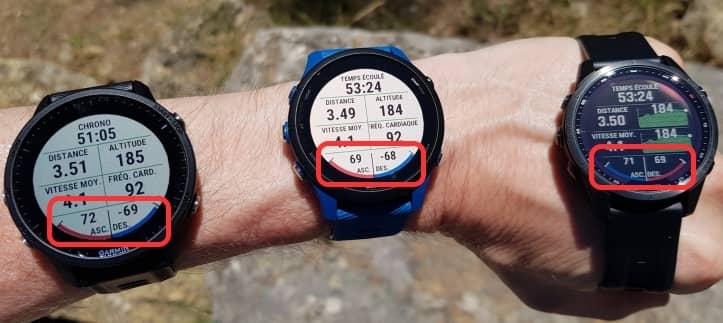
Sports functions
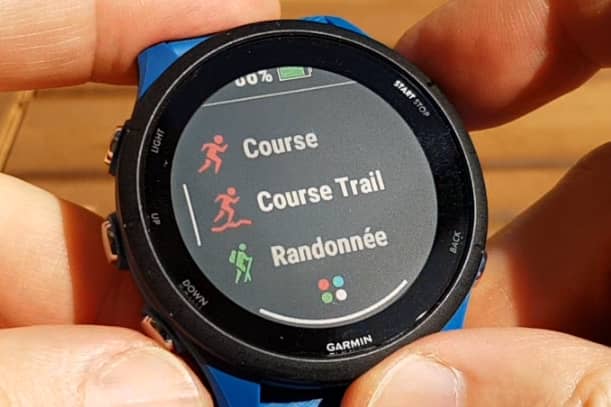
In terms of sports functions, Forerunner 255 offers all the tools you need to do sports, train, monitor your progress, improve your technique or compete. It has almost all the tools of the top-of-the-range Forerunner 955. It's perfectly equipped for leisure sports, but also for training, preparing for or running an event.
Its thirty or so sports profiles will suit most users. Here is the complete list to date:
- Outdoor endurance: running, trail running, virtual running, track running, cycling, swimming (pool, open water), walking, hiking, ultra deep, electric cycling, mountain biking, eVTT
- Triathlon, multisport
- Winter sports: skiing, snowboarding, cross-country skiing
- Water sports: stand up paddle, rowing
- Indoor sports: treadmill, weight training, HIIT, cardio, yoga, Pilates, elliptical, stepper, rowing machine, stair climbers, indoor cycling, indoor running,
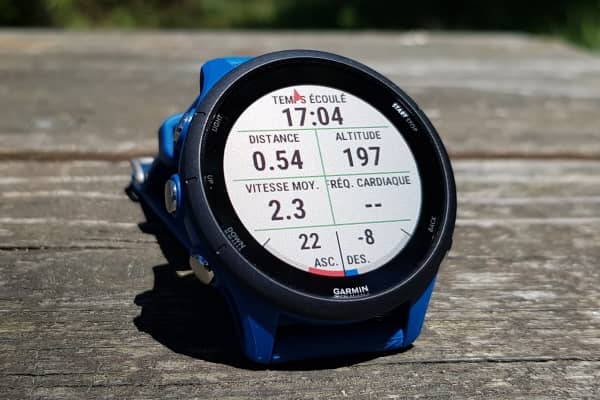
As described above, the customisable sports screens can display up to 6 data fields. Garmin is expanding the list of data fields and adding the ability to display gauges and graphs.
This model has all the features of the Forerunner 245 and offers new features, some of which are inherited from the Fenix 7:
Native running power and power-based training
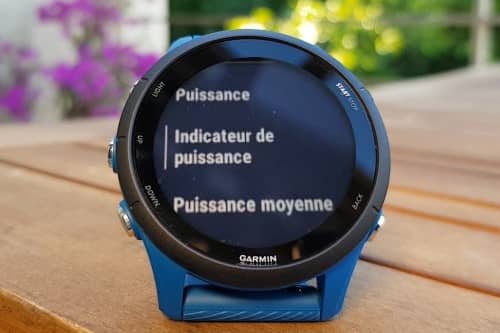
Garmin now offers native power on this model. It allows you to display running power and to program and track power-based workouts.
Unlike Polar or Coros, the function requires an external sensor (HRM-Pro cardio belt or Running Dynamics Pod) but there is no longer any need to go through a third party application to be loaded from Garmin Connect. This makes things much simpler, although we would have liked a sensorless solution. That said, with the barometric altimeter now present on this new model, Garmin is able, through a software update, to offer this at any time.
Race widget
A new Race widget provides additional help to runners in preparing for a race. This feature provides training tips and suggestions as well as a race time prediction based on the planned date of the event, the goal set, the recorded performance and the expected weather on race day. This is an additional tool to the daily training suggestions.
VFC status
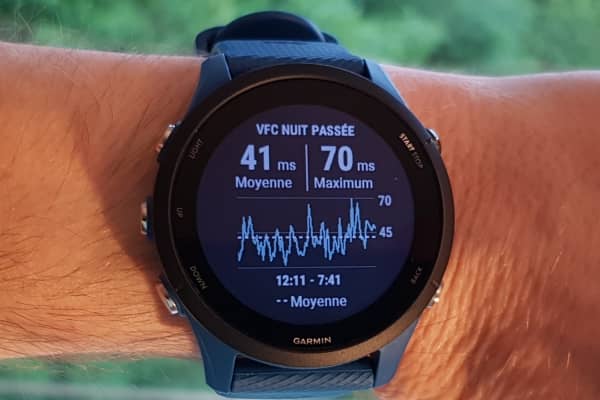
Garmin offers a continuous measurement of HRV (heart rate variability) during sleep. The data is used to assess general health, recovery and performance level.
The watch needs 3 weeks to evaluate the average VFC which will then be used as a reference to indicate the state of form in the form of an easy to interpret gauge. While waiting for these 3 weeks, we can already know the value of the last night as well as a graph for the last night and the average of the nightly VFC over 7 days.
Morning report
This new report is displayed in the morning when you wake up and summarises some essential data: sleep quality, VFC, training suggestions for the day, and the day's weather. You can program the indicators to be displayed.
We advise you to set your sleeping time wide enough to avoid being woken up in the morning by the screen turning on!


Daily training suggestions
Daily Training Suggestions, already available on Forerunner 55, provides recommendations for activities to maintain your fitness levels. They are based on past workouts and current fitness level. They take into account training status and load, VO2max, recovery time, sleep data, past training data (running and cycling only).
The feature has been enhanced to provide workouts over the whole week instead of day-by-day suggestions. They adapt according to training, performance and recovery and take into account upcoming races
Other new features
Garmin is fine-tuning features such as run time predictor, status and training load.
Thanks to the barometric altimeter, the watch displays in real time the positive and negative altitude difference (ascents / descents) and the percentage of slope.
The functions already present on the old model
The Forerunner 255 has all the functions of the Forerunner 245. You can find a description of these in our detailed model review. Here is a summary of the main features:
- Sports coach: free adaptive training programmes that can be used for example to prepare for a race (5 km, 10 km, half-marathon, marathon)
- Running time predictor: the watch indicates the estimated time to run a 5 km, 10 km, half or marathon based on past training
- Programming of simple and complex workouts
- Future elevation profile
- PacePro: a useful function for managing your pace according to the difficulty of the terrain (the watch calculates the best pace according to the effort to be made and the goal to be reached). The function can be programmed in Garmin Connect or directly from the watch by simply indicating a time or pace objective.
- Running dynamics (stride analysis): stride length, vertical oscillation, ground contact time, right-left balance, etc.
- Training status: indicators of whether training is optimal (balance between core, aerobic and anaerobic, VFC status, VO2max, acute load)
- Comprehensive physiological measurements: VO2max, VO2max adjusted for trail conditions, lactic threshold, training effect, recovery time, etc.
- Assessment of heat and altitude acclimatisation
Testing GPS navigation and outdoor functions
The Garmin Forerunner 255 offers advanced GPS navigation features including track display, route tracking, backtracking and turn-by-turn guidance. It also has a number of useful outdoor tools such as a compass, thermometer, weather, barometric trend, storm alerts and moon/sun information. Most of these features were not available on the previous model.
To follow a route , you must first create it in the Garmin application and load it into the watch, or load an existing route (GPS file for example) or navigate along a route already saved on the watch (in this case, you will not benefit from turn-by-turn guidance).
The turn-by-turn guidance is very effective. The watch displays the upcoming turns with the distance to the turn. It emits a very audible beep (a bit too much for our taste) and/or a vibration. It is better to deactivate them because they are frequent. We would have liked Garmin to indicate only the tight turns (as Suunto does very well).
If you go off course and catch up later, the watch finds its bearings and resumes its guidance as if nothing had happened.

It is unfortunate that the zoom (cropping) applied to the map does not constantly remain at the value you have given it. The watch resets it after a few seconds and this is quite frustrating when you try to follow the track closely so as not to miss a junction (when you want to retrace your steps or follow a route you have already completed, as turn-by-turn guidance is not available in these cases).
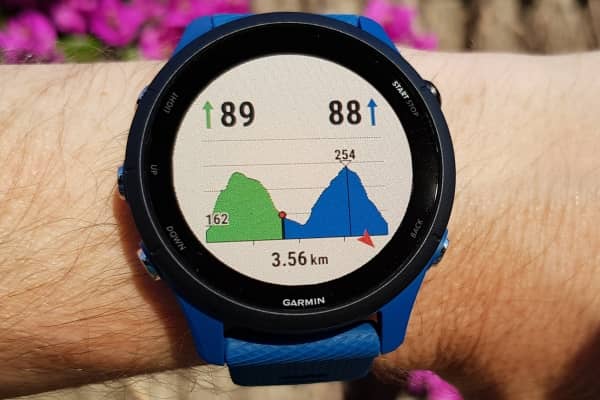
New to the model, the Forerunner 255 displays speed of ascent, gradient, percentage of slope. All this is in addition to the existing altitude profile display.
The watch is able to calculate distance and 3D speed, useful data in the mountains when the slopes are steep (trail, climbing, hiking).
Autonomy test
8 to 25% more autonomy
Garmin improves the autonomy, especially on the big model. We go from 24 hours to 26 hours for the Forerunner 255S and 30 hours for the Forerunner 255 in GPS only mode. The multiband divides this autonomy by 2.
In practice, on the 255, we found about 12% battery consumption per day for one hour of sport in multiband GPS mode. This includes the display of about ten notifications and the use of the automatic backlight in sport mode only. This means that the watch can be used for 8 days without recharging. One hour of sport consumes about 6 to 7% of the battery (still in multiband GPS mode), i.e. about 14 to 16 hours of autonomy, which corresponds roughly to the figures announced by Garmin (16 hours for this model).
The watch charges in about 1.5 hours (40% in 30 minutes). It can also be recharged during sport, but you have to take it off your wrist to be able to connect the charging cable! However, do not try to recharge it via a PC during an outing (for example during a refuelling break). The watch is detected as a USB stick and this stops the activity in progress! You can connect it to an external battery and continue to access the functions.
A new power manager but it is restricted
The watch embeds the new power manager present on the Fenix 7 but in a much less complete way, so much so that its interest is meagre. It allows you to activate the power saving mode in watch mode (the watch can thus last more than 2 months with a basic display, a brightness set to the minimum, the deactivation of the optical cardio and the activity tracking). The power manager also allows you to indicate whether you want to know the percentage of battery remaining and the estimated battery life. The same tool is found on the Forerunner 955.

The Fenix 7 offers a much better battery manager. It allows you to set predefined or personal battery modes where you can specify the GPS mode, which sensors to use, etc. That said, it is quite complex to use and can easily lead to misconfiguration, especially when selecting the GPS mode.
Activity tracking and connected features
Forerunner 955 offers comprehensive activity and health tracking including sleep tracking on the watch. It displays a sleep score out of 100 that takes into account total sleep time, duration of different sleep phases (REM, deep, light) and stress level.

A new "Health snapshot" widget allows you to assess the main health indicators: heart rate and its variability, stress level, breathing rate, SpO2, by means of a 2-minute test at rest. To start a session, select the "Health snapshot" activity in the sports activities (top right button). The results of previous sessions can be found in the Health overview of the Quick overviews (press the DOWN button).

The "Steps", "Stress" and "Body battery" widgets display the number of steps, the stress level and the energy available for the day as well as a graph of the week displaying the average values. Garmin has simplified the displays by removing the display of the average value calculated for the week. A pity!

The watch offers many connected functions. Here are the main ones.
A new feature allows direct access to the Connect IQ shop from the watch (via phone or Wi-Fi) to download new watch faces or data fields.
All Forerunner 255 models can control music from a smartphone (in addition to the MP3 player on the Music model).
Garmin Pay, the contactless payment solution that allows you to pay directly with your watch, is now available on this model.
There are functions to be followed live on the Internet (LiveTrack) and to send predefined messages (real-time event sharing) to friends.
Forerunner 255 can detect falls and send an SOS message if assistance is needed.
It can control a VIRB camera and can be connected to a home trainer or an electric bike. It is compatible with VARIA lights and radars.
It displays the weather, a calendar and other useful tools.
To sum up, it really does offer a lot of useful functions for sports and everyday life.

The application
Garmin offers the Garmin Connect application on PC and Smartphone. It provides access to all recorded data (activity, health). The application displays all the data recorded by the watch as well as complete graphs.
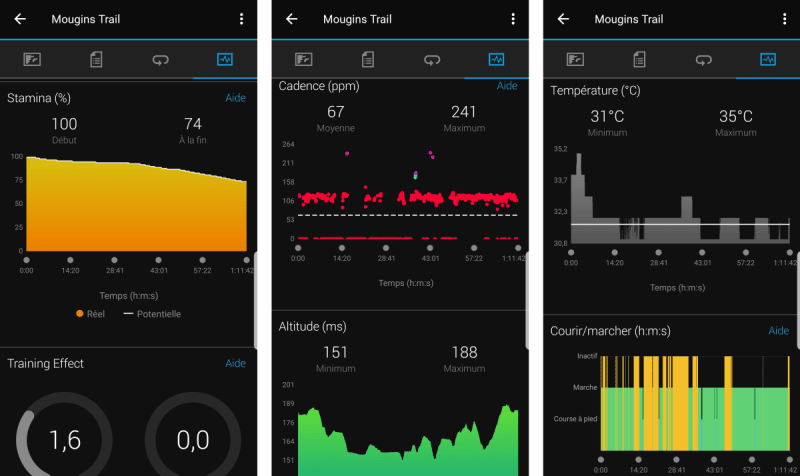
The application provides access to a number of tools for tracking health data, creating a training programme and creating a route. Creating a route is easy with just a few clicks. You can let the application suggest a looped route based on a given sport (trail, running, cycling, mountain biking, gravel biking, other), a given starting point, direction and distance. Alternatively, you can draw the route yourself by marking points on the map. Once the route has been defined, it can be transferred to the watch.
Garmin offers on the Forerunner 255, the synchronization of settings from the watch to the application and vice versa. This is very practical. Similarly, if you have several Garmin watches, you can use each one as you wish (a watch for sport, a watch for everyday use for example): the application synchronises certain data between the watches (number of steps, VO2 max for example) and consolidates the activity data in the Garmin Connect application. There is no need to declare a watch when using it. The platform can manage several watches in parallel.
Our opinion
The Forerunner 2x5 series (235, 245, 255) is a key series in the Garmin range. It is the American company's most successful watch, the one that appeals to the most sportsmen and women in the world, especially runners, for its comprehensive functions including GPS navigation, all at an affordable price.
This new Garmin Forerunner 255 / 255 Music model has almost nothing to do with the old one. Multisport and triathlon, with better components (4ème generation optical monitor, bigger and better definition screen on the big model, barometric altimeter, ultra-precise dual-frequency GPS, thermometer, gyroscope), richer functions, including wrist power, more complete tools for the runner's training, the watch is very close to the top-of-the-range Forerunner 955 model. It is the mapping, the touch screen and, depending on the model, the autonomy, which makes almost the only difference.
The Forerunner 245 was our favourite running watch because of its comprehensive functions, compact size, low weight and affordable price. The Forerunner 255 offers much more for not much more. It's definitely an excellent choice.

With the new barometric altimeter that was missing on the previous model, the watch can now be used for trail running, hiking and skiing. The power measurement on the wrist is a great asset for training (more efficient than training based on heart rate) even if we would have liked to see a solution without external sensor like Polar or Coros.
We appreciate the new multi-band GPS which offers impressive accuracy. The claimed accuracy of multiband is no longer just theory or a sales pitch to sell the watch, it has become a reality. This GPS really makes a difference to other modes, especially in places where the GPS signal is not as good or where there is reverberation, such as in the forest, in the mountains or in the city.
The slightly better battery life, which is sufficient even for relatively long runs, will suit most sportsmen and women. The MP3 player is a plus for sportsmen and women who like to do sports with music without having to carry a phone with them. Those with a limited budget can save €50 by choosing the model without music.

Finally, the 2 case sizes allow more flexibility with a better reading comfort and a watch better adapted to wide wrists. The only regret is that Garmin only offers the small model (255S) in 2 colours: pink and grey. This limits the choice for men knowing that the Forerunner 245 (of similar size) existed in more varied colours!
The price, €50 more than the Forerunner 245 at launch, is largely justified by the additional sensors and features. It's also now the cheapest of Garmin's triathlon watches. That said, it is becoming less affordable and may encourage athletes who are prepared to do without GPS navigation to prefer the more comprehensive and significantly cheaper Forerunner 55.
Given the features offered for the price, this model should be a hit but also overshadow the models just above it in the range (Forerunner 645 and Forerunner 745). These will probably not be renewed.
Verdict
The Forerunner 255 is much more complete than its predecessor and in our opinion is the best compromise watch for most sportsmen. The barometric altimeter makes it suitable for trail running, skiing and hiking. The 2 case sizes offer a perfect fit for all wrists. The sports tools are more complete than those of the previous model. The watch offers a triathlon profile. The dual-frequency GPS is ultra-precise. The higher price is justified by these additions but makes the Forerunner 255 less accessible to everyone. A watch that should still be a hit in the next few years and that is close to the top model but without mapping and without a touch screen. We loved the old model, we loved this one!
- Multi-band and multi-GNSS GPS, ultra-precise
- The presence of a barometric altimeter
- Native running power
- 2 case and screen sizes
- 6 data fields per screen
- The new sports functions
- 30+ sports profiles
- An MP3 player (optional)
- Limited colours for the 255S model
- Basic power management compared to Fenix 7
- Somewhat stiff and noisy buttons
Price and availability
The Forerunner 255S/255 and Forerunner 255S/255 Music are available in 8 colours (2 colours per model) for €349.99 (255S and 255 models) and €399.99 (255S Music and 255 Music models). Discover them at our partners at the best price and take advantage of coupons de réduction on our site.
Buy Forerunner 255
Buy Forerunner 255 Music
Commercial links. Prices are not contractual. Please visit the merchant site.
Sources:
These articles may also interest you
Photo credit : Adobe Stock. This article contains commercial links.

